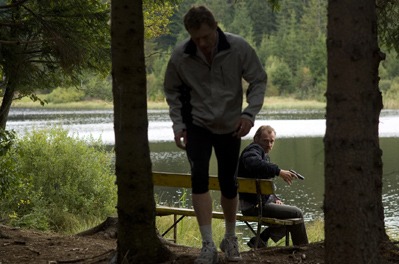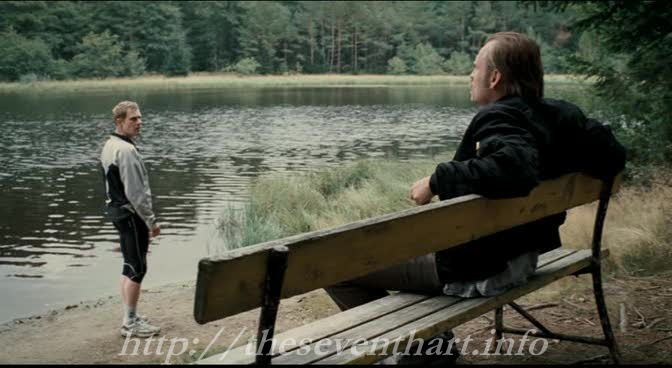One of the reasons I really like older movies is due to the camera work allowing the viewer to get a sense of spatial relationship and really take in the beauty of a well staged shot.
However it seems like so much of what I see, the camera just jerks all over the place and is too close to the action to really get a sense of what is going on. Sometimes this hand held style serves a purpose - like in Cloverfield, or Blair Witch Project where it plays into the story. Even a movie like Traffic does it to get the "in your face" and "being in the chaos of the moment" feel.
But it's used too much and detracts from film. Take this shot below from Savages. It's a wonderful shot, but Stone doesn't allow the characters to have their discussion all within this one frame. The movie would have been better to hold this still for a minute or two while the characters engage in dialogue.

One thing I really liked about Revanche, Drive, and a couple other films I've seen recently is that they do allow the viewer to take in the beauty of the images they create. For example in Revanche we see the film go back to a bench along a character's jog in a park. Through multiple scenes the camera not only stays still but returns to the same spot and we get the same view almost. For me this builds up sense of being there, location, and so on. Many films I like will have the camera return to the same angle, distance, location - even when it edits into something else. Also I like the medium distance. In the world we view our surroundings in medium distance. Only when we get to manipulate items, objects, or whatever do we see things in extreme closeup. Look at these shots from Revanche.




All similar styling. Even though the distance changes a bit, and in one the angle switches. We still have spatial value and it's meaningful. Nature has created a beautiful location and the director/photographer/editor doesn't need to do anything fancy to capture this. We know where the bench is in relationship to the lake, in relationship to the trees, the sky, and the characters.
However it seems like so much of what I see, the camera just jerks all over the place and is too close to the action to really get a sense of what is going on. Sometimes this hand held style serves a purpose - like in Cloverfield, or Blair Witch Project where it plays into the story. Even a movie like Traffic does it to get the "in your face" and "being in the chaos of the moment" feel.
But it's used too much and detracts from film. Take this shot below from Savages. It's a wonderful shot, but Stone doesn't allow the characters to have their discussion all within this one frame. The movie would have been better to hold this still for a minute or two while the characters engage in dialogue.

One thing I really liked about Revanche, Drive, and a couple other films I've seen recently is that they do allow the viewer to take in the beauty of the images they create. For example in Revanche we see the film go back to a bench along a character's jog in a park. Through multiple scenes the camera not only stays still but returns to the same spot and we get the same view almost. For me this builds up sense of being there, location, and so on. Many films I like will have the camera return to the same angle, distance, location - even when it edits into something else. Also I like the medium distance. In the world we view our surroundings in medium distance. Only when we get to manipulate items, objects, or whatever do we see things in extreme closeup. Look at these shots from Revanche.




All similar styling. Even though the distance changes a bit, and in one the angle switches. We still have spatial value and it's meaningful. Nature has created a beautiful location and the director/photographer/editor doesn't need to do anything fancy to capture this. We know where the bench is in relationship to the lake, in relationship to the trees, the sky, and the characters.
__________________
"A candy colored clown!"
Member since Fall 2002
Top 100 Films, clicky below
http://www.movieforums.com/community...ad.php?t=26201
"A candy colored clown!"
Member since Fall 2002
Top 100 Films, clicky below
http://www.movieforums.com/community...ad.php?t=26201